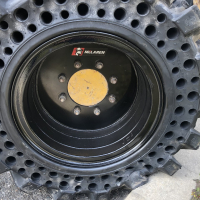
Press-On vs. Bonded Wheel Solid Skid Steer Tires

Two of the most common types of solid skid steer tires are press-on rim and bonded wheel type solid skid steer tires. Bonded to wheel type solid skid steer tires refer to tires that have a rim that is bonded to the rubber tire. Press-on tires, on the other hand, aren’t bonded to the rim and can be press-on and off the wheel. To help you decide which type of skid loader solid tire is right for your application, check out this side-by-side comparison of press-on vs. bonded wheelsolid skid steer tires.
Advantages of Bonded Tires
The main advantage of bonded tires is that there is no potential for wheel slip. Wheel slip refers to when the wheels’ rim slips inside of the tire. When wheel slip occurs, the seal on the tire breaks, and the tire will need resealing or even re pressing to the wheel.
Even when pushing heavy loads in extreme conditions daily or there is a high chance for an impact from a curb ect..., bonded tires will not slip. As such, bonded industrial solid rubber tires, such as McLaren’s Nu-Air X- Dirt Terrain series, are ideal for pushing loads with a large amount of impact.
Disadvantages of Bonded Tires
While bonded tires eliminate wheel slip, they don’t provide less cushioning. The lack of suspension and cushioning places more stress on the axles and drive train of a skid steer, which can significantly decrease its lifespan. In addition, a tire with poor cushioning can also have a negative impact on the operator by increasing operator fatigue and the risk of lower back injury over time.
Plus, bonded tires are also less versatile. If you want to move your bonded wheel tires to a new, upgraded machine, the bolt holes on the rims might not match up, and you will need to purchase a new machine. Or, if you hit a curb the wrong way and end up damaging and bending the rim, you’ll have to scrap the entire wheel rather than just the tire since the rim and tire are bonded together.
Advantages of Press-On Tires
Mirroring the disadvantages of bonded tires, the primary advantages of press-on tires are their cushioning soft ride and versatility to change rims. Because you can take the tire off of a rim, operators have the freedom to move their tires to different machines with ease.
Or, if you want a different offset of your wheel to make them closer to your machine or farther out, press-on tires give you the freedom to do so. All you would have to do is press the rubber tire of the tire off of the rim, purchase a rim with your desired offset, and press the tire back on. Similarly, if wheel damage occurs, you can just press on a new wheel, rather than scraping the entire tire.
Are there Disadvantages of Press-On Tires?
There are almost no disadvantages of press-on type solid skid steer tires versus bonded type. Over the last 20 years McLaren has refined the press-on type skid loader tire to be superior in comfort, versatility, and price. Because of these advantages developed by McLaren, press-on type skid steer tires account for 95% of the solid skid steer tire market share.
McLaren Industries is your one-stop shop for all your solid skid steer tire needs. For over two decades, McLaren has been the leader in skid steer solid tires. Because press-on tires are ideal for the majority of applications and offer superior versatility and comfort, 95 percent of our product range consists of press-on tires, rather than bonded wheel tires. However, we also offer exceptional quality bonded tires for those who are working in very specific applications. To learn more about or innovative press-on and bonded wheel skid steer tires, contact us today.

 By McLaren Industries
By McLaren Industries